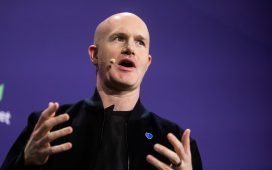DETROIT, MI – APRIL 29: A fan trades a baseball card on the trade wall during the 2023 Topps Truck Tour promotion outside of Comerica Park during game one of a doubleheader between the Baltimore Orioles and the Detroit Tigers at Comerica Park on April 29, 2023 in Detroit, Michigan. The Tigers defeated the Orioles 7-4. (Photo by Mark Cunningham/MLB Photos via Getty Images)
Mark Cunningham | Getty Images Sport | Getty Images
When I was a kid, I collected baseball cards with the money I earned from mowing lawns. It was fun to open a pack of cards not knowing which ones you’d get. I sometimes bought a bunch of cards of a particular rookie, in hopes he would one day become an All-Star. Most of the time, however, I ended up striking out. I learned the only way to make sure that you owned a future star was to diversify by buying every card in the set.
There are parallels to investing.
Many folks try to find the next Amazon or Nvidia. But let’s face it, no one — not even professional investors, with all the resources behind them — knows for sure how any individual stock will perform going forward.
But there are ways to mitigate the risk of striking out with any one individual stock — buy many stocks or even the whole stock market. It’s the same idea as buying whole sets of baseball cards to get that one future All-Star. Jack Bogle, the founder of Vanguard, used a different analogy to convey the same idea: “Don’t try to find the needle, buy the haystack.”
By haystack, he was talking about buying the entire stock market through a broad-based index fund instead of trying to find those few winning individual stocks. However, some may argue that just a handful of stocks have a disproportionate weighting in the index, so a U.S. equity index fund may not be as diversified as you may think.
The roster of stars keeps changing
Over the years, pundits have come up with interesting names to describe the largest or most-coveted stocks, such as the Nifty Fifty, FAANG and the Magnificent Seven. The latter, as of year-end 2023, were the most valuable U.S. companies, making up more than a quarter of the S&P 500 Index’s market capitalization. True, some of today’s winners will end up being tomorrow’s losers, but many will continue to become tomorrow’s winners as well. And some modest-size stocks will grow into behemoths.
For example, Apple, Microsoft and Google were among the five largest U.S. stocks in March 2014 and they remain so 10 years later. Exxon Mobil and Berkshire Hathaway rounded out the top five in March 2014, but were replaced by Amazon and Nvidia. Back then, Amazon was worth roughly $150 billion, while Nvidia was valued at a relatively modest $10 billion. Both stocks were included in broadly diversified U.S. stock indexes in 2014 and grew into top-five stocks today.
You never know which names will be the future All-Stars 10 years from now, so diversification is key. And diversification can be gained across three levels:
Diversify within each asset class. As mentioned, the easiest means of diversification is through a broad-based index fund or ETF. However, you do not have to stick strictly with index funds. If you go with actively managed funds to complement a core holding of index funds, make sure that your collective portfolio is adequately diversified and keep your costs like expense ratios and other fees low.
Diversify across asset classes. Diversifying across equities, bonds and cash further reduces risk. Make sure your allocation is appropriate for your time horizon, risk tolerance, and financial goals.
Diversify across time. In most cases, investing in a lump sum leads to higher returns. On the other hand, while dollar-cost averaging — regularly investing a fixed amount over time — doesn’t guarantee a profit or protect against a market downturn, it does mitigate the risk of bad market timing. And if you set it up as automated investments, it has the added benefit of being a set-it-and-forget-it approach. As time passes, regularly revisit your plan to make sure it still matches your current circumstances. Life happens, things change and so can your target allocation.
I’ll state the obvious: All investing is subject to risk, including possible loss of principal. Diversification does not ensure a profit or protect against a loss; and no particular asset allocation can guarantee you will meet your goals.
That said, if you diversify, you’ll have some share of the potential All-Stars in your investment lineup.
— By James Martielli, head of investment and trading services at Vanguard.










